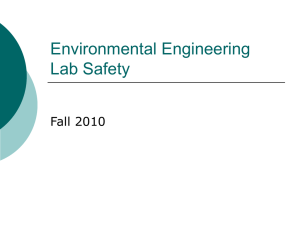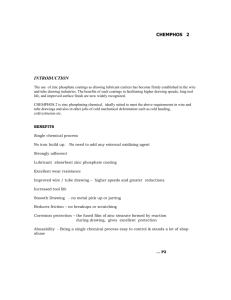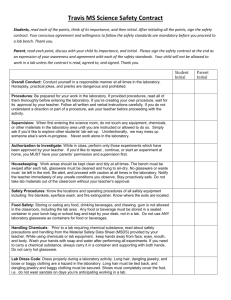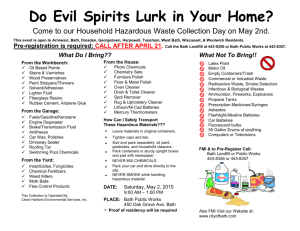Glassware Cleaning
advertisement
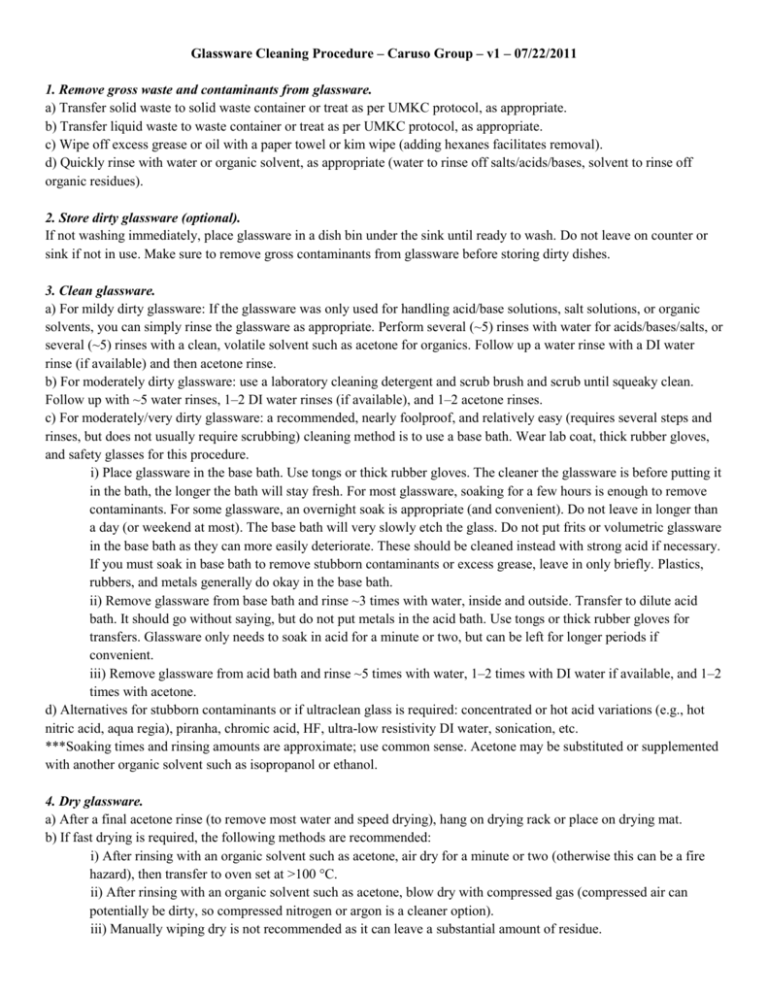
Glassware Cleaning Procedure – Caruso Group – v1 – 07/22/2011 1. Remove gross waste and contaminants from glassware. a) Transfer solid waste to solid waste container or treat as per UMKC protocol, as appropriate. b) Transfer liquid waste to waste container or treat as per UMKC protocol, as appropriate. c) Wipe off excess grease or oil with a paper towel or kim wipe (adding hexanes facilitates removal). d) Quickly rinse with water or organic solvent, as appropriate (water to rinse off salts/acids/bases, solvent to rinse off organic residues). 2. Store dirty glassware (optional). If not washing immediately, place glassware in a dish bin under the sink until ready to wash. Do not leave on counter or sink if not in use. Make sure to remove gross contaminants from glassware before storing dirty dishes. 3. Clean glassware. a) For mildy dirty glassware: If the glassware was only used for handling acid/base solutions, salt solutions, or organic solvents, you can simply rinse the glassware as appropriate. Perform several (~5) rinses with water for acids/bases/salts, or several (~5) rinses with a clean, volatile solvent such as acetone for organics. Follow up a water rinse with a DI water rinse (if available) and then acetone rinse. b) For moderately dirty glassware: use a laboratory cleaning detergent and scrub brush and scrub until squeaky clean. Follow up with ~5 water rinses, 1–2 DI water rinses (if available), and 1–2 acetone rinses. c) For moderately/very dirty glassware: a recommended, nearly foolproof, and relatively easy (requires several steps and rinses, but does not usually require scrubbing) cleaning method is to use a base bath. Wear lab coat, thick rubber gloves, and safety glasses for this procedure. i) Place glassware in the base bath. Use tongs or thick rubber gloves. The cleaner the glassware is before putting it in the bath, the longer the bath will stay fresh. For most glassware, soaking for a few hours is enough to remove contaminants. For some glassware, an overnight soak is appropriate (and convenient). Do not leave in longer than a day (or weekend at most). The base bath will very slowly etch the glass. Do not put frits or volumetric glassware in the base bath as they can more easily deteriorate. These should be cleaned instead with strong acid if necessary. If you must soak in base bath to remove stubborn contaminants or excess grease, leave in only briefly. Plastics, rubbers, and metals generally do okay in the base bath. ii) Remove glassware from base bath and rinse ~3 times with water, inside and outside. Transfer to dilute acid bath. It should go without saying, but do not put metals in the acid bath. Use tongs or thick rubber gloves for transfers. Glassware only needs to soak in acid for a minute or two, but can be left for longer periods if convenient. iii) Remove glassware from acid bath and rinse ~5 times with water, 1–2 times with DI water if available, and 1–2 times with acetone. d) Alternatives for stubborn contaminants or if ultraclean glass is required: concentrated or hot acid variations (e.g., hot nitric acid, aqua regia), piranha, chromic acid, HF, ultra-low resistivity DI water, sonication, etc. ***Soaking times and rinsing amounts are approximate; use common sense. Acetone may be substituted or supplemented with another organic solvent such as isopropanol or ethanol. 4. Dry glassware. a) After a final acetone rinse (to remove most water and speed drying), hang on drying rack or place on drying mat. b) If fast drying is required, the following methods are recommended: i) After rinsing with an organic solvent such as acetone, air dry for a minute or two (otherwise this can be a fire hazard), then transfer to oven set at >100 °C. ii) After rinsing with an organic solvent such as acetone, blow dry with compressed gas (compressed air can potentially be dirty, so compressed nitrogen or argon is a cleaner option). iii) Manually wiping dry is not recommended as it can leave a substantial amount of residue. BASE BATH PREPARATION Initial Preparation: 1. Suit up with appropriate protective equipment (lab coat, gloves, eye protection). 2. Fill the bottom of a large, sturdy container with a thin layer of ice. 3. Pour KOH pellets on top of ice. 4. Carefully pour in isopropanol, taking care not to splash. ***Add ~250 g of KOH pellets for every 4 L of solvent. A large bath can take ~1 kg of KOH pellets and 15–20 L of isopropanol. ***Variations: Water can be added instead of ice (~1 L for every 4 L of solvent), but the ice works well to help control the heat. NaOH can be substituted for KOH, and methanol or ethanol can be substituted for isopropanol. Maintenance: a) If level is too low: top up with KOH and isopropanol as required. b) If bath is too full of particulate or too greasy, can siphon off particulate/water from the bottom or grease from the top. If the base bath is too dirty, dispose of contents appropriately and make a fresh one. ***A base bath should last a LONG time. DILUTE ACID BATH PREPARATION Initial Preparation: 1. Suit up with appropriate protective equipment (lab coat, gloves, eye protection). 2. Add water and concentrated HCl to a large, sturdy container in an ~8:1 ratio (this might look something like 8 L of water and 1 L of HCl). ADD WATER FIRST to avoid acid splashes. When HCl is added, chlorine gas will be generated. Either prepare in fumehood, or be careful to not inhale fumes when combining acid with water (closing the lid immediately and not staying in the area is recommended). Maintenance: a) If bath is becoming neutral from use, top up with additional HCl. b) If bath is too dirty, treat waste as per UMKC protocol and make a fresh bath.



